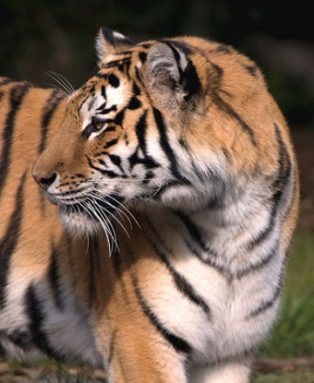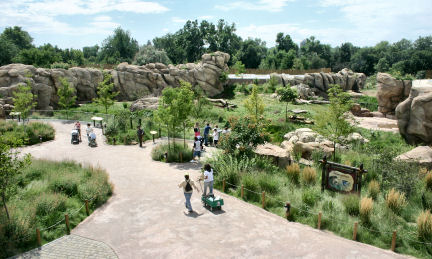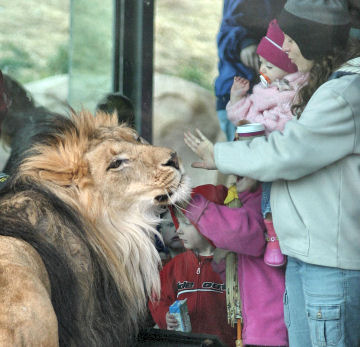The other side of the zoo fence
Zoo designers work hard to make exhibits safe and enjoyable—for people as well as animals.
By Emily Sohn
Architects often have to deal with difficult clients, but Lee Ehmke’s customers are especially hard to work for. They sleep through meetings. They never pay. They don’t even use bathrooms when they have to go.
Nevertheless, Ehmke puts up with such rude behavior, and he does it happily. Why? Because he designs homes for gorillas, bears, lions, and other zoo animals. And he enjoys the challenge of looking at the world through their exotic eyes.
“The role of a zoo designer is to think as much as possible about what will make each animal comfortable, happy, and active,” says Ehmke, director of the Minnesota Zoo in Apple Valley.
“It would be wrong to say you can know what an animal is thinking and feeling,” he adds. “But we do our best to get as close to that as possible when we’re designing homes for them.”
 |
|
In an extremely rare incident, this tiger, named Tatiana, escaped from her enclosure recently at the San Francisco Zoo.
|
| Matt Knoth/Wikipedia |
Most zoo visitors focus on the animals, not on the habitats and barriers that fence the animals in. But details like these have received extra attention since December, when a female Siberian tiger escaped her enclosure at the San Francisco Zoo. The 4-year-old, 350-pound cat killed one person and injured two others.
The incident raised fears among zoo goers and sent staff at zoos across the nation rushing to evaluate how safe their own exhibits are. Still, experts say, the tragic event should not scare people away from zoos.
“There have probably been 5 billion visits to zoos in the last 50 years,” Ehmke says. “This is the first time this has happened.”
Zoo evolution
Zoos have been around for centuries—and they’ve changed a lot over the years. In the Middle Ages, wealthy people kept exotic animals in their gardens. Public animal parks appeared in European cities in the late 1700s and early 1800s. The Philadelphia Zoo, the first in the United States, opened in 1874.
Until a few decades ago, most zoos were organized by creature—primates in one area, cats in another, birds somewhere else. Like museum collections, displays such as these aimed to teach people about taxonomy—or the science of classifying animals into groups, says Craig Piper, president of the Denver Zoo.
In recent years, zoos have instead begun grouping animals that would normally interact in the wild. Moreover, instead of confining animals behind bars, designers are creating landscapes that resemble the environments in which these creatures would naturally be found. Nearby signs provide information about the animals, their habitats, and threats to the environment in parts of the world where they normally live.
“These animals come from real places,” Piper says. “The reason they become endangered is because of what happens in those places.”
The Denver Zoo’s new Predator Ridge exhibit, for example, aims to teach visitors about Africa. Eight acres of land provide homes for 14 animal species, including lions, spotted hyenas, porcupines, cranes, and wild dogs. Plants from the region grow alongside rocky outcroppings that mimic the African terrain. Ten-foot-tall mounds give lions a place from which to survey their surroundings, just as they would do in the wild.
 |
|
Landscape design makes visitors to the Denver Zoo’s Predator Ridge exhibit feel like they’re really in Africa.
|
| Denver Zoo/David Parsons |
Inhabitants of Predator Ridge can’t actually mingle with one another, for safety reasons. But hidden moats and other subtle landscaping features allow visitors to see all the animals at once. Different species can see each other too.
In ways like these, zoos are also working to keep animals’ lives interesting. Within Predator Ridge, handlers regularly but unpredictably rotate the lions, hyenas, and dogs through three landscapes. The changing sights and smells make the animals more likely to explore their environments. Staff at many zoos also frequently give animals new things to eat or play with.
And when animals are comfortable, people are happy. Studies show that visitors feel better about zoos and animals after seeing them in natural settings, Ehmke says. When zoo animals are active, visitors spend more time watching them. They ask more questions. They read more of the accompanying signs. Designers hope that such visitors will also take a greater interest in conservation.
Planning, planning, planning
Putting together a new zoo exhibit often takes years of work, Piper says. The process begins with conversations between designers and zoologists, botanists, educators, designers, maintenance workers, animal handlers, and other experts.
“We gather all these people together and say, ‘How do these animals live in the wild?'” Piper explains. “We always start with things like, ‘Tell us about a day in the life of a lion.'”
Lions, it turns out, sleep a lot. Monkeys like to climb trees. And hippos need water to wade in. In each case, the challenge is to figure out how to let the animal behave naturally, while still making the exhibits interesting—and safe—for zoo goers. As the incident in San Francisco illustrates, stakes are high when wild, predatory animals are involved.
At the Minnesota Zoo, Ehmke and his crew spent 4 years preparing for last summer’s opening of an area called Russia’s Grizzly Coast. The exhibit features several animals new to the zoo, including brown bears, Amur leopards, and wild boars.
To create new spaces that are safe for both animals and people, zoo designers talk with staff at other facilities to learn what they’ve done in the past. They also look to field researchers for help.
 |
|
Glass enclosures and other features help people get up close and personal with zoo animals.
|
| Denver Zoo/David Parsons |
A scientist working in Africa, for example, once watched a male chimpanzee leap an astonishing 23 feet, Piper says. (The researcher measured the distance between the chimp’s footprints in the mud.). At the time, standard guidelines recommended that zoos build 22-foot-wide barriers around chimp exhibits. Once the scientist reported the chimp’s enormous leap, these guidelines were quickly revised upward.
Other safety measures include hilly landscapes that prevent animals from gathering speed for big leaps. Water pipes and electrical wiring are installed where animals can’t get at them. Zoo staff and independent inspectors regularly look for fallen trees, loose hinges, and other potential threats to the animals’ safety. And handlers make sure they can see every animal before entering an enclosure.
The bottom line, experts say, is that zoos are safe, but it is always important to stay vigilant. The design of the San Francisco Zoo’s big cat grotto, for example, may be partly to blame for the recent tiger escape. At the time of the attack, a 33-foot-wide concrete moat and a 12.5-foot-tall wall surrounded the exhibit, even though the Association of Zoos and Aquariums recommends that walls around tiger enclosures measure at least 16.5 feet high.
 |
| Sohan Singh |
Although the tiger did leap over the wall, what prompted the attack is unknown. Some reports, for example, have suggested that the victims in the attack harassed and provoked the animal. That emphasizes the importance of treating zoo animals with respect—the same way you’d want visitors to act in your home. Investigations continue in San Francisco, and design changes are under way.
“The big cat grotto will be closed until the Zoological Society decides it’s fit for reopening,” says Rose Marie Dennis, spokeswoman for the San Francisco Recreation and Park Department. But the rest of the ocean-side zoo is open. And, she adds, “it’s a really lovely place to visit.”
Going Deeper:







